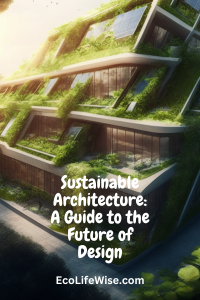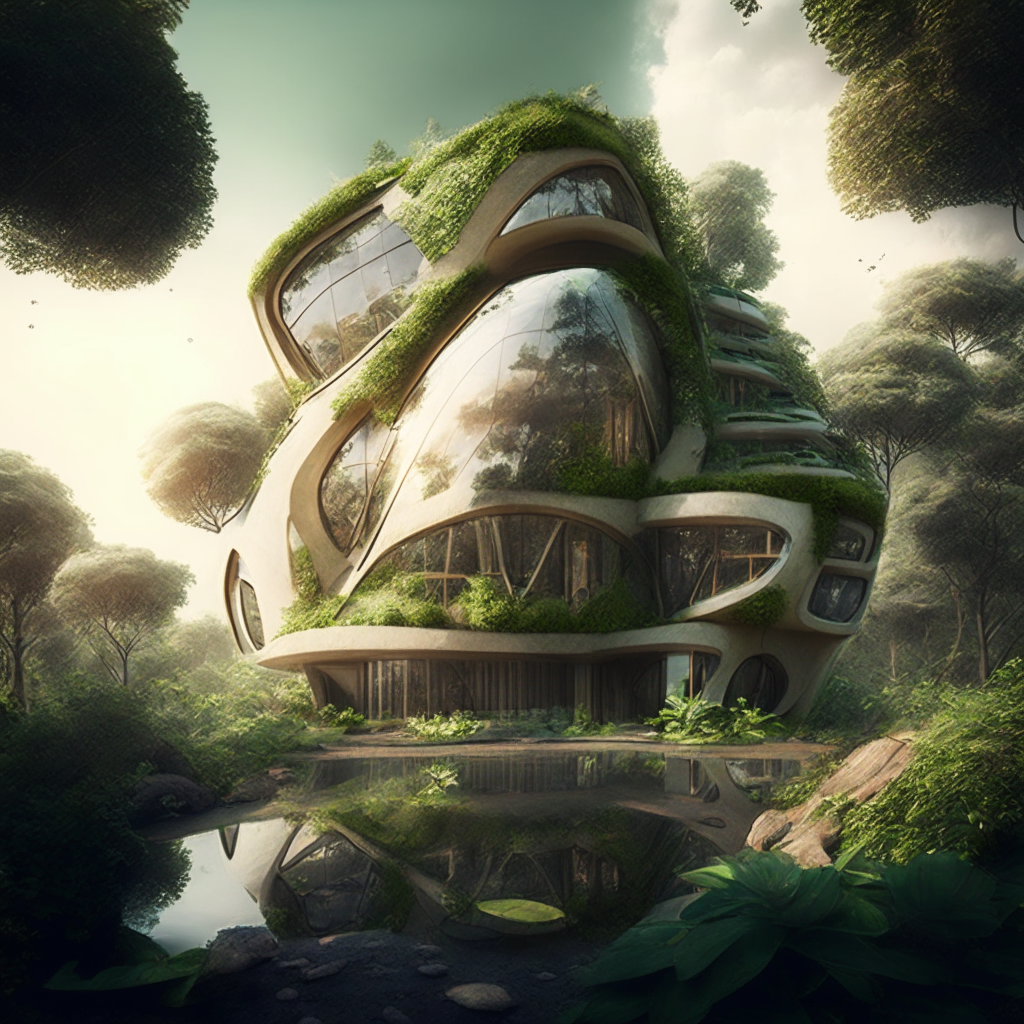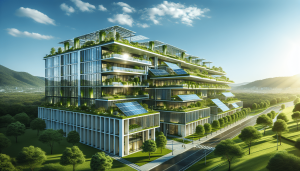Introduction: Embracing the Green Revolution in Architecture
The world is waking up to the importance of sustainability. The conversation about climate change has shifted from ‘if’ to ‘when,’ and in response, every industry is looking for ways to reduce its carbon footprint. Right at the forefront of this eco-revolution is the field of architecture. Sustainable architecture, or green building, is rapidly becoming more than a buzzword. It’s a lifeline to a healthier planet and happier inhabitants. In this article, we will dive into sustainable architecture, why it’s important, and how you can incorporate it into your own life. Trust me; it’s not as daunting as you might think. In fact, it can be a fun and rewarding journey!
Defining Sustainable Architecture: It’s Not Just About Buildings
At its core, sustainable architecture is about designing and constructing energy-efficient, environmentally friendly, and sustainable buildings over the long term. Essentially, it’s about creating structures that don’t just take from the planet but give back. We’re not talking about buildings that grow on trees, but hey, wouldn’t that be something?
Why Sustainable Architecture Matters: More Than Just a Trend
Sustainable architecture isn’t just a cool trend or a token for businesses to show they care about the environment. It’s a critical response to the urgent challenge of climate change. Buildings account for nearly 40% of global CO2 emissions. That’s a big slice of the carbon pie! By designing and building more sustainably, we can significantly reduce this impact. Plus, who wouldn’t want to live or work in a building that’s healthier, more comfortable, and has lower utility bills?
The Macro View: Transforming Urban Landscapes
The shift towards sustainable architecture isn’t just a pipe dream. Cities worldwide are embracing this concept, reshaping their skylines with structures that are as eco-friendly as they are impressive. Take, for instance, the iconic Bosco Verticale in Milan – a pair of residential towers adorned with over 900 trees, 5000 shrubs, and 11000 floral plants. This vertical forest is like a giant air purifier in the heart of the city. Talk about a breath of fresh air!
Countries Leading the Way in Sustainable Architecture
Several countries are leading the way in sustainable architecture, with notable projects that exemplify the principles of green building.
Denmark: Copenhagen’s 8 House
Denmark, especially its capital, Copenhagen, is often hailed as a leader in sustainable architecture. An impressive example is the 8 House, a mixed-use building that integrates residential and commercial spaces in an energy-efficient design. The building’s unique figure-eight shape encourages community interaction and allows for excellent daylighting, reducing the need for artificial lighting.
Singapore: Gardens by the Bay
Singapore, a city-state with limited land area, has embraced sustainable architecture with fervor. The Gardens by the Bay is a prime example, with its solar-powered “supertrees” and climate-controlled biomes. The project showcases Singapore’s commitment to creating a ‘city in a garden.’
Germany: Vauban District, Freiburg
Germany, renowned for its engineering prowess, has put its expertise to use in the Vauban district in Freiburg. This car-free neighborhood features energy-plus homes (buildings that produce more energy than they consume), shared green spaces, and excellent public transportation, making it a model of sustainable urban development.
United States: Bullitt Center, Seattle
The United States is also home to several sustainable architectural marvels. One example is the Bullitt Center in Seattle, touted as the greenest commercial building in the world. It’s a six-story structure designed to have a 250-year lifespan and produces more energy than it uses, thanks to a large rooftop solar array. It also features a rainwater collection system, composting toilets, and other green features. Talk about taking sustainability to new heights!
Australia: One Central Park, Sydney
Down Under, Australia is making strides in sustainable architecture, with Sydney’s One Central Park as a standout example. The building’s striking vertical gardens and mirrored cantilever are aesthetically pleasing and serve practical purposes. The gardens help to regulate temperature, while the cantilever hosts a solar reflector that directs sunlight to shaded areas of the building.
United Kingdom: The Crystal, London
The United Kingdom is no slouch when it comes to sustainable architecture either. The Crystal in London, a sustainable cities initiative by Siemens, is one of the world’s greenest buildings. It runs entirely on renewable energy, uses rainwater harvesting, and has electric vehicle charging stations. A futuristic gem indeed!
Canada: The VanDusen Botanical Garden Visitor Centre, Vancouver
Canada, renowned for its breathtaking landscapes, is also embracing green buildings. The VanDusen Botanical Garden Visitor Centre in Vancouver is a testament to this. It’s designed to be net-zero energy, equipped with solar panels, geothermal heating, and a living roof. A nature lover’s dream come true!
United Arab Emirates: Masdar City
The United Arab Emirates, a country known for its architectural marvels, is also making headway in sustainable architecture. Masdar City, a planned city project in Abu Dhabi, is designed to be a zero-waste, car-free city. The city is powered by renewable energy and is a hub for cleantech companies.
The New Wave: Biophilic Design in Sustainable Architecture
In recent years, the concept of biophilic design has gained traction in the world of sustainable architecture. This design principle seeks to connect people and nature within built environments for enhanced well-being and productivity. It emphasizes using natural light, fresh air, and plant life. Remember how good you feel after a walk in the park? Imagine having that feeling in your home or office!
Promoting Health and Wellbeing
Beyond environmental sustainability, green buildings contribute significantly to human health and well-being. For instance, improved indoor air quality and natural lighting have been linked to increased productivity and reduced stress levels. It’s like having a spa day every day!
The Economic Case for Sustainable Architecture
Contrary to what some might think, sustainable architecture isn’t just good for the planet—it’s good for your wallet, too! While sustainable buildings may require a higher initial investment, the long-term savings in energy and water bills often outweigh the upfront costs. Plus, as demand for sustainable buildings grows, these properties can fetch a higher resale value. It’s like the golden goose of real estate!
Sustainable Architecture and Community Development
Sustainable architecture plays a pivotal role in community development. Green buildings often incorporate public spaces to foster community interaction, and their construction can create local jobs and stimulate the local economy. It’s like building a stronger, more connected neighborhood, one green building at a time!
The Future of Sustainable Architecture
The future of sustainable architecture is bright, with exciting developments on the horizon. The possibilities are boundless, from buildings that can generate more energy than they consume (net-positive buildings) to the use of innovative materials like self-healing concrete or transparent solar panels. As we continue to push the envelope of what’s possible, one thing’s for sure: the future of architecture is green!
In conclusion, as we face the pressing challenges of climate change, sustainable architecture offers a path forward. It’s a way for us to create self sustaining homes and other buildings that are not just places to live or work but spaces that nourish our bodies, minds, and the planet. As we continue to innovate and learn, I can’t help but be excited about the journey ahead. Who knows, the next iconic building could be your eco-friendly dream home!
Overcoming the Challenges
Adopting sustainable architecture isn’t without its challenges. From regulatory hurdles to a lack of awareness and the need for skilled professionals, there are obstacles to overcome. But hey, no great change ever came without a few bumps in the road, right? As more people recognize the urgency of climate change and the value of sustainable living, these challenges can become stepping stones to a greener future.
How to Implement Sustainable Architecture in Your Own Space
So now that you’re hopefully as excited about sustainable architecture as I am, you might be wondering how to incorporate it into your own space. Well, strap on your green-thinking caps, and let’s dive in!
Taking the First Step: Energy Audit
An energy audit is like a health check-up for your home. It helps diagnose areas where you’re using more energy than necessary. Think of it as a personal trainer for your house. Only instead of losing weight, you’re shedding off those extra kilowatts!
Choosing the Right Materials: A Checklist
Choosing the right materials is a crucial aspect of sustainable architecture. Here’s a checklist to help you make sustainable choices. Trust me; it’s easier than choosing what to watch on Netflix tonight!
- Locally-Sourced: Local materials reduce the carbon footprint associated with transporting goods long distances. Plus, you get to support your local economy. It’s like getting your cake and eating it too!
- Recycled or Recyclable: Materials that can be recycled or are made from recycled goods are great for sustainable construction. It’s like giving old materials a new lease of life!
- Durability: Durable materials last longer, reducing the need for frequent replacements. No more worrying about wear and tear!
- Non-Toxic: Non-toxic Materials are better for indoor air quality and overall health. It’s like having a breath of fresh air inside your home.
- Renewable: Materials like bamboo or cork are renewable alternatives to traditional wood. It’s like borrowing from nature without being a bad guest.
Optimizing Water Use
Water efficiency is another vital aspect of sustainable architecture. Consider installing low-flow fixtures, collecting rainwater for irrigation, or implementing a greywater system. It’s all about making every drop count!
Landscaping for Sustainability
Your outdoor space also plays a role in sustainability. Native plants require less water and care and provide habitat for local wildlife. It’s like having a mini nature reserve in your backyard. Who needs a safari when you have sustainable landscaping?
Making the Most of Technology
Technology is a powerful tool in sustainable architecture. From smart thermostats that optimize heating and cooling to energy-efficient appliances, technology can help reduce your environmental footprint while enhancing comfort and convenience. It’s like having your own personal eco-butler!
Conclusion: Embracing the Future with Sustainable Architecture
In conclusion, sustainable architecture is not just a trend—it’s a paradigm shift in how we conceive, construct and inhabit buildings. It’s a design philosophy that respects our planet, maximizes efficiency, and fosters healthier living spaces. And the best part? It’s a journey we can all be a part of. So, are you ready to join the green revolution? I promise it’s more fun than watching paint dry!
Frequently Asked Questions
- What does sustainable architecture look like?
- Sustainable architecture can take many forms, depending on the specific environmental, social, and economic contexts. While some sustainable buildings may have distinctive features like green roofs or solar panels, many green design strategies are invisible to the naked eye. A sustainably designed building can have any architectural style.
- What’s the role of technology in sustainable architecture?
- Technology significantly improves energy efficiency, from smart thermostats and energy-efficient appliances to home energy management systems. It can also be used to model and optimize designs for energy efficiency and comfort.
- Can I retrofit my existing home to be more sustainable, or do I need to build a new one?
- Many aspects of sustainable architecture can be incorporated into existing buildings, such as improving insulation, installing energy-efficient appliances, or setting up a rainwater harvesting system. While some sustainable strategies might be easier to implement in new construction, don’t let that deter you from making existing spaces more eco-friendly.
- Why is sustainable architecture important for communities?
- Sustainable architecture can help communities reduce their environmental impact, improve residents’ health and well-being, and stimulate the local economy by creating green jobs and utilizing local materials. It’s a holistic approach that benefits individual buildings and the community.
- What are some examples of sustainable architecture?
- There are many examples of sustainable architecture around the world, from the Bullitt Center in Seattle, USA, touted as the greenest commercial building in the world, to the Gardens by the Bay in Singapore, featuring solar-powered “supertrees” and climate-controlled biomes. These examples showcase the innovative approaches and potential of sustainable architecture.
So, there you have it, folks! We’ve covered the why, the how, and the wow of sustainable architecture. As we wrap up, remember that every little step counts. Even small changes can make a big difference. So, why not start today? After all, there’s no place like a green home!






Pingback: Flexible Solar Panels: Eco Friendliness With a Bend & a Twist! - Eco Life Wise
Pingback: Off Grid Trailers: The Ultimate Guide - Eco Life Wise
Pingback: Sustainable Shoe Brands: A Step Towards a Greener Future
Pingback: Navigating the World of Sustainable Clothing Brands
Pingback: Sustainable Gifts: An Eco-Friendly Choice - Eco Life Wise
Pingback: Self Sustaining Homes: A Definitive Guide to the Exciting Future
Pingback: Sustainable Fashion Brands: Redesigning Style Responsibly
Pingback: Living Off the Grid Communities: A Practical Guide
Pingback: Eco Friendly Sustainability: Introducing The GreenPrint Initiative
Pingback: Unlock the Secret to Affordable Sustainable Clothing
Pingback: Why is Recycling Important? A Definitive Guide | Eco Life Wise
Pingback: Facts About Recycling: Conserving Resources & Building Sustainability
Pingback: Pros and Cons of Solar Energy: Weighing it Up | Eco Life Wise
Pingback: Sustainable Swimwear: A Deep Dive Into Eco Friendly Choices
Pingback: Upcycled Clothes: The Art Of Renewing Your Wardrobe | Eco Life Wise
Pingback: Organic Modernism: A Resurgence of Nature in Design | Eco Life Wise
Pingback: Eco Friendly Gifts: A Sustainable Guide | Eco Life Wise
Pingback: Composting Toilets: From Waste to Wonder and Fertilizer Gold!
Pingback: Building Off the Grid: A Guide to a Self-Sustained Lifestyle
Pingback: What Is A Green Building? | Eco Life Wise
Pingback: How Does Self-Sustaining Architecture Differ From Traditional Architecture? | Eco Life Wise
Pingback: How Does Self-Sustaining Architecture Differ From Traditional Architecture? 7 Big Ways | Eco Life Wise
Pingback: What Role Do Materials Play In Self-Sustaining Architecture? 10 Considerations | Eco Life Wise
Pingback: How Does Upcycling Reduce Waste And Consumption? 10 Innovative Ways | Eco Life Wise